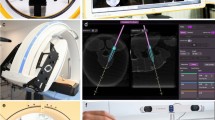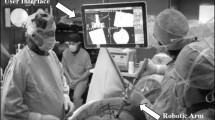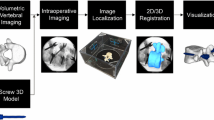Abstract
Background
Two-dimensional image guidance and navigation can help to reduce the number of misplaced pedicle screws, but do not completely prevent misplacement. This experimental, retrospective, non-inferiority study was designed to evaluate and compare the efficacy of a novel 3D imaging technique versus conventional postoperative CT-scan, for intra-operative determination of pedicle screw position accuracy.
Methods
The capacity of C-OnSite® to intraoperatively assess screw placement was evaluated in 28 clinical cases and 23 deliberately misplaced screws in a cadaver model, and compared to placement accuracy determined by standard CT. The position of each implant, as viewed by both modalities, was graded by three neurosurgeons, one orthopaedic-surgeon and one radiologist. The intermodal variance determined the difference between CT- and C-OnSite® results for each observer, while the inter-observer variance measured the difference between ratings of the same modality by different observers.
Results
C-OnSite® successfully assessed 120/138 screws (25/28 cases). Mean procedural fluoroscopy time was 132 ± 51s, and 40 ± 16s per C-OnSite® scan. The average inter-modality variance was ,15 % with mismatches >1° between C-OnSite® and the gold-standard imaging technique in only 2 % of the comparisons. Average inter-observer variances were about similar (12 % for CT and 18 % for C-OnSite®), with deviations of >1° reaching 1 % for CT and 3 % for C-OnSite®. Individual variances between experienced only observers differed even less.
Conclusions
C-OnSite® is a feasible, reliable and intuitive means of intraoperatively visualizing pedicle screw positions and might render the majority of postoperative CTs superfluous. C-OnSite® might help avoid re-operations for screw re-positioning.



Similar content being viewed by others
References
Ebmeier K, Giest K, Kalff R (2003) Intraoperative computerized tomography for improved accuracy of spinal navigation in pedicle screw placement of the thoracic spine. Acta Neurochir Suppl 85:105–113
Güven O, Yalçin S, Karahan M, Sevinç TT (1994) Postoperative evaluation of transpedicular screws with computed tomography. Orthop Rev 23:511–516
Hoang JK, Yoshizumi TT, Toncheva G, Gray L, Gafton AR, Huh BK, Eastwood JD, Lascola CD, Hurwitz LM (2011) Radiation dose exposure for lumbar spine epidural steroid injections: a comparison of conventional fluoroscopy data and CT fluoroscopy techniques. AJR Am J Roentgenol 197:778–782
Hubbe U, Kogias E, Vougioukas VI (2009) Image guided percutaneous trans-pedicular screw fixation of the thoracic spine. A clinical evaluation. Acta Neurochir 151:545–549
Jeon CH, Chung NS (2014) A simple intraoperative method for assessment of pedicle screw trajectory using contrast medium injection. J Spinal Disord Tech 27(1):E14–E19
Kantelhardt SR, Martinez R, Baerwinkel S, Burger R, Giese A, Rohde V (2011) Perioperative course and accuracy of screw positioning in conventional, open robotic-guided and percutaneous robotic-guided, pedicle screw placement. Eur Spine J 20:860–868
Kantelhardt SR, Bock HC, Siam L, Larsen J, Burger R, Schillinger W, Bockermann V, Rohde V, Giese A (2010) Intra-osseous ultrasound for pedicle screw positioning in the subaxial cervical spine: an experimental study. Acta Neurochir 152:655–661
Kosay C, Akcali O, Berk RH, Erbil G, Alici E (2001) A new method for detecting pedicular wall perforation during pedicle screw insertion. Spine 26:1477–1481
Lee GY, Massicotte EM, Rampersaud YR (2007) Clinical accuracy of cervicothoracic pedicle screw placement: a comparison of the "open" lamino-foraminotomy and computer-assisted techniques. J Spinal Disord Tech 20:25–32
Maguire J, Wallace S, Madiga R, Leppanen R, Draper V (1995) Evaluation of intrapedicular screw position using intraoperative evoked electromyography. Spine 20:1068–1074
Martin BI, Mirza SK, Comstock BA, Gray DT, Kreuter W, Deyo RA (2007) Are lumbar spine reoperation rates falling with greater use of fusion surgery and new surgical technology? Spine 32:2119–2126
Papadopoulos EC, Girardi FP, Sama A, Sandhu HS, Cammisa FP Jr (2005) Accuracy of single-time, multilevel registration in image-guided spinal surgery. Spine J 5:263–267
Quiñones-Hinojosa A, Robert Kolen E, Jun P, Rosenberg WS, Weinstein PR (2006) Accuracy over space and time of computer-assisted fluoroscopic navigation in the lumbar spine in vivo. J Spinal Disord Tech 19:109–113
Schizas C, Michel J, Kosmopoulos V, Theumann N (2007) Computer tomography assessment of pedicle screw insertion in percutaneous posterior transpedicular stabilization. Eur Spine J 16(5):613–617
Schwarzenbach O, Berlemann U, Jost B, Visarius H, Arm E, Langlotz F, Nolte LP, Ozdoba C (1997) Accuracy of computer-assisted pedicle screw placement. An in vivo computed tomography analysis. Spine 22:452–458
Shin BJ, James AR, Njoku IU, Härtl R (2012) Pedicle screw navigation: a systematic review and meta-analysis of perforation risk for computer-navigated versus freehand insertion. J Neurosurg Spine 17:113–122
Tian NF, Huang QS, Zhou P, Zhou Y, Wu R-K, Lou Y, Xu HZ (2011) Pedicle screw insertion accuracy with different assisted methods: a systematic review and meta-analysis of comparative studies. Eur Spine J 20:846–859
von Jako R, Finn MA, Yonemura KS, Araghi A, Khoo LT, Carrino JA, Perez-Cruet M (2011) Minimally invasive percutaneous transpedicular screw fixation: increased accuracy and reduced radiation exposure by means of a novel electromagnetic navigation system. Acta Neurochir 153:589–596
Wiesner L, Kothe R, Schulitz KP, Rüther W (2000) Clinical evaluation and computed tomography scan analysis of screw tracts after percutaneous insertion of pedicle screws in the lumbar spine. Spine 25:615–621
Yamazaki T, Matsudaira K (2007) Diathermy testing: a novel method with electric knife stimulation to avoid nerve injuries during lumbar pedicle screw placement. Tech Note J Neurosurg Spine 6:479–484
Acknowledgments
The lumbar spine specimen was kindly provided by Prof. Konerding, Institute for Functional and Clinical Anatomy, Johannes Gutenberg-University Mainz, Germany.
Clinical CT-imaging and experimental CT-imaging of the spine specimen was kindly performed by Prof. Müller-Forell, Institute of Neuroradiology, University Medical Center, Johannes Gutenberg-University Mainz, Germany.
Conflict of interest
Mazor Robotic Inc. provided editorial support for this paper. No further possible conflicts have to be declared.
Author information
Authors and Affiliations
Corresponding author
Rights and permissions
About this article
Cite this article
Kantelhardt, S.R., Keric, N., Conrad, J. et al. C-OnSite® for intraoperative 3D control of pedicular screw positions. Acta Neurochir 156, 1799–1805 (2014). https://doi.org/10.1007/s00701-014-2111-z
Received:
Accepted:
Published:
Issue Date:
DOI: https://doi.org/10.1007/s00701-014-2111-z




